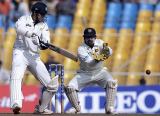In the end India achieved a fairly comprehensive win at Ahmedabad to seal the series, but it didn't always look as if the final result would be quite so decisive as the 259-run margin - India's fourth-largest in terms of runs - suggests. Before tea on the opening day, India had slumped to 97 for 5. It wasn't much better in the second innings, when half the batsmen were back in the hutch for 100. The most encouraging aspect of the win was the way India's lower order contributed, scoring more than 72% of the total team runs. It's too early to pass judgment on whether a meatier lower-order contribution will become the norm, but the discipline and commitment shown by Mahendra Singh Dhoni and Irfan Pathan suggests better times.
The table below lists the most runs scored by India's last five - the effort at Ahmedabad shares the fourth spot, along with the effort against South Africa in 1996-97 at Cape Town.
In fact, over the last couple of years, India's lower order has acquitted itself quite well - the average of 26.97 per wicket is only lower than South Africa and New Zealand, and marginally higher than Australia and England. New Zealand are well ahead of the rest of the pack, but equally, the 42% contribution they make to the total suggests that their top order is less effective than other line-ups, forcing the lower order to make vital contributions. The table below indicates how the last five wickets have contributed to team totals in Tests since 2004 - for Bangladesh and Zimbabwe, the percentage contribution is very high, which proves how brittle their top order is. The table also exposes just how brittle West Indies' lower order has been - they fare worse than all other sides.
Over the last few years, India's top order has been solid enough to ensure that the tail hasn't scored a very high percentage of total runs, but in 1991, when India embarked on that disastrous
tour to Australia, the lower order had plenty to do. India played only two Tests that year - at Brisbane and Melbourne - and with the specialist batsmen struggling to cope with the pace and bounce, it was left to Kiran More and the rest of the tail to bail the team out. That year, the last five wickets contributed a whopping 65% of India's total runs. Next year, a
tour to South Africa ensured more rescue acts were needed, but the number dropped to a still significant 45%. Apart from a couple of instances in the 1980s, and one in 1996 - when, again, the team went to South Africa - the percentage has never crossed 40.
Spinning against India
Muttiah Muralitharan ended up with 16 wickets in the three Tests, but failed to wreck the kind of havoc he was expected to - save the spectacular collapse he triggered in the Indian first innings at Delhi, Murali wasn't quite Sri Lanka's saviour. A hamstring injury surely had a role to play, but the expertise of the Indian batsmen in playing spin bowling again came to the fore.
That India's players are more adept than others in coping with the turning delivery has been accepted by most experts, yet there have been some spinners in history who have found more success against India than against other sides. Richie Benaud, the Australian legspinner, managed a phenomenal haul of
52 wickets from just eight Tests against India at 18 apiece, almost nine lesser than his career average. There were a couple of others who performed outstandingly against India (among spinners with at least 30 wickets against them):
Ray Illingworth and
Hedley Verity have tremendous records against India, while
Lance Gibbs's offspin has got him a fair degree of success as well. Among the current lot of spinners, Saqlain Mushtaq and Danish Kaneria have a reasonable record against the Indians, but they miss the 30-wicket cut. Another Pakistani spinner achieved outstanding success against most other teams, but the Indians had little trouble unravelling his mysteries: Abdul Qadir played
16 Tests against them, but managed a meagre haul of just 27 wickets at an exorbitant 51.52 apiece, nearly 19 more than his career average. It's a fate he shares with another legspin wizard -
Shane Warne travails against India have been written about far too often to warrant a more detailed analysis in this column.
Rudolph's resistance
Going into the final day of the Perth Test, most Australians would have reckoned that the match was pretty much in the bag. What they might not have expected, though, was that one batsman would bat through the entire day and save the match for South Africa; after all, it isn't every day that a batsman resists an Australian attack for more than 400 minutes in the fourth innings of a Test. Since 1990, only once has a batsman survived more than the 431 minutes Jacques Rudolph battled at Perth: Ijaz Ahmed made 121 in 450 minutes in 1989-90
at Melbourne. To get the previous such instance in a Test against Australia, you'd have to go back to 1976-77, when Derek Randall batted 446 minutes in the
Centenary Test. Both Ijaz and Randall failed to save their teams from defeat, though. Rudolph's marathon, on the other hand, has ensured that South Africa go into the Boxing Day Test with honours even.
Among the fourth-innings rescue acts against all teams since 1990, Michael Atherton comes up on top with his 643-minute epic against South Africa at Johannesburg. Rudolph's effort gets him a place in the top six, though.
